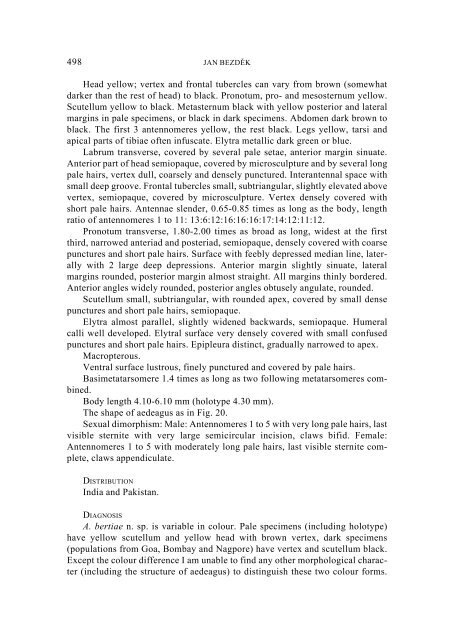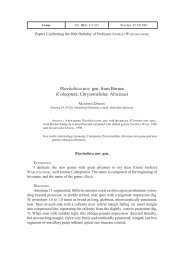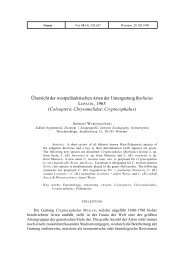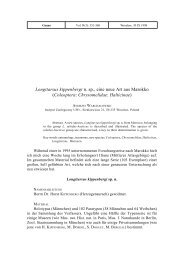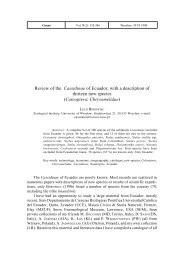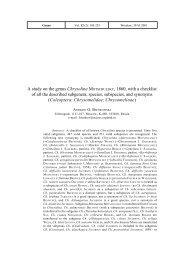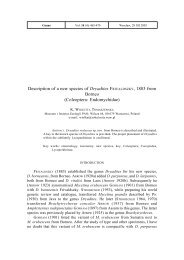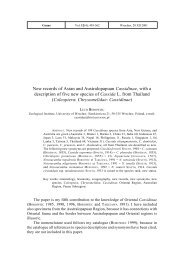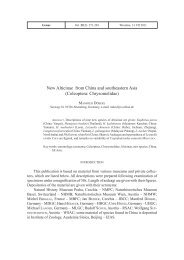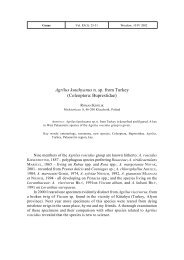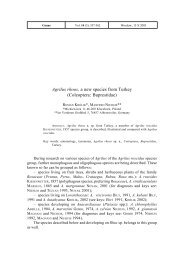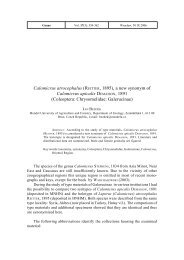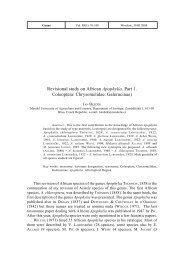Studies on asiatic Apophylia. Part 5: Revisional study of type ...
Studies on asiatic Apophylia. Part 5: Revisional study of type ...
Studies on asiatic Apophylia. Part 5: Revisional study of type ...
Create successful ePaper yourself
Turn your PDF publications into a flip-book with our unique Google optimized e-Paper software.
498 JAN BEZDÌK<br />
Head yellow; vertex and fr<strong>on</strong>tal tubercles can vary from brown (somewhat<br />
darker than the rest <strong>of</strong> head) to black. Pr<strong>on</strong>otum, pro- and mesosternum yellow.<br />
Scutellum yellow to black. Metasternum black with yellow posterior and lateral<br />
margins in pale specimens, or black in dark specimens. Abdomen dark brown to<br />
black. The first 3 antennomeres yellow, the rest black. Legs yellow, tarsi and<br />
apical parts <strong>of</strong> tibiae <strong>of</strong>ten infuscate. Elytra metallic dark green or blue.<br />
Labrum transverse, covered by several pale setae, anterior margin sinuate.<br />
Anterior part <strong>of</strong> head semiopaque, covered by microsculpture and by several l<strong>on</strong>g<br />
pale hairs, vertex dull, coarsely and densely punctured. Interantennal space with<br />
small deep groove. Fr<strong>on</strong>tal tubercles small, subtriangular, slightly elevated above<br />
vertex, semiopaque, covered by microsculpture. Vertex densely covered with<br />
short pale hairs. Antennae slender, 0.65-0.85 times as l<strong>on</strong>g as the body, length<br />
ratio <strong>of</strong> antennomeres 1 to 11: 13:6:12:16:16:16:17:14:12:11:12.<br />
Pr<strong>on</strong>otum transverse, 1.80-2.00 times as broad as l<strong>on</strong>g, widest at the first<br />
third, narrowed anteriad and posteriad, semiopaque, densely covered with coarse<br />
punctures and short pale hairs. Surface with feebly depressed median line, laterally<br />
with 2 large deep depressi<strong>on</strong>s. Anterior margin slightly sinuate, lateral<br />
margins rounded, posterior margin almost straight. All margins thinly bordered.<br />
Anterior angles widely rounded, posterior angles obtusely angulate, rounded.<br />
Scutellum small, subtriangular, with rounded apex, covered by small dense<br />
punctures and short pale hairs, semiopaque.<br />
Elytra almost parallel, slightly widened backwards, semiopaque. Humeral<br />
calli well developed. Elytral surface very densely covered with small c<strong>on</strong>fused<br />
punctures and short pale hairs. Epipleura distinct, gradually narrowed to apex.<br />
Macropterous.<br />
Ventral surface lustrous, finely punctured and covered by pale hairs.<br />
Basimetatarsomere 1.4 times as l<strong>on</strong>g as two following metatarsomeres combined.<br />
Body length 4.10-6.10 mm (holo<strong>type</strong> 4.30 mm).<br />
The shape <strong>of</strong> aedeagus as in Fig. 20.<br />
Sexual dimorphism: Male: Antennomeres 1 to 5 with very l<strong>on</strong>g pale hairs, last<br />
visible sternite with very large semicircular incisi<strong>on</strong>, claws bifid. Female:<br />
Antennomeres 1 to 5 with moderately l<strong>on</strong>g pale hairs, last visible sternite complete,<br />
claws appendiculate.<br />
DISTRIBUTION<br />
India and Pakistan.<br />
DIAGNOSIS<br />
A. bertiae n. sp. is variable in colour. Pale specimens (including holo<strong>type</strong>)<br />
have yellow scutellum and yellow head with brown vertex, dark specimens<br />
(populati<strong>on</strong>s from Goa, Bombay and Nagpore) have vertex and scutellum black.<br />
Except the colour difference I am unable to find any other morphological character<br />
(including the structure <strong>of</strong> aedeagus) to distinguish these two colour forms.


